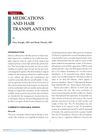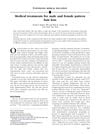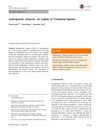Insane dutasteride shed 4 months after switching. Finasteride/Dutasteride 10/26/2023
The post and conversation are about a user's experience with hair loss treatments, specifically switching from finasteride to dutasteride. The user experienced significant hair shedding after the switch, with others suggesting patience, noting similar experiences, or questioning the user's decision and medical consultation.
View this post in the Community →
Similar Community Posts Join
6 / 1000+ resultscommunity Minoxidil aint shit, genetics are dumb, i dont want to be bald
Minoxidil alone is not effective for significant hair regrowth; combining it with finasteride or dutasteride is necessary. Additional treatments like hair transplants, microneedling, or oral medications are recommended for better results.
community Study shows further evidence that finasteride and dutasteride take 12-18 months or more to show significant results. Do NOT give up early
The conversation discusses the effectiveness of finasteride and dutasteride in treating hair loss, emphasizing that significant results often take 12-18 months or more. Dutasteride is generally considered superior, with similar or fewer side effects than finasteride, but patience is required for noticeable improvement.
community Next month marks 2 years on Dutasteride. When does it start working?
A user has been on dutasteride for nearly 2 years with no improvement in hair loss, expressing frustration. Other users suggest checking for other health conditions, getting bloodwork, and considering stopping TRT or trying finasteride.
community Husband (35) is thinning on top, he doesn't know yet. Trying to research so he won't feel so lost or upset when I tell him. Help a girl out?
A woman is concerned about her husband's hair thinning and researches treatments like finasteride and minoxidil. He decides against medication due to potential side effects and plans to shave his head if necessary.
community A meta analysis of 18 popular hair loss treatments. An 2022 guide on efficacy. From finasteride and minoxidil to caffeine shampoo, saw palmetto and biotin. 96 Scientific References included.
Most hair loss treatments are ineffective; only finasteride, dutasteride, and minoxidil show effectiveness.
community Why is everyone not directly advised Dutasteride?
Dutasteride is less commonly prescribed for hair loss because it is not FDA-approved for this purpose, unlike finasteride, which is more accessible and preferred due to fewer side effects. Dutasteride may be more effective in reducing DHT but has a longer half-life and potentially more significant side effects.
Related Research
6 / 1000+ results
research Medications and Hair Transplantation
Minoxidil and finasteride combined can effectively treat hair loss.

research Medical Treatments for Male and Female Pattern Hair Loss
Minoxidil and finasteride treat hair loss in men, while minoxidil treats hair loss in women.

research Experimental and Early Investigational Drugs for Androgenetic Alopecia
New hair loss treatments may include topical medications, injections, and improved transplant methods.

research Addressing Androgenetic Alopecia: A Complex Disorder with a Multilateral Treatment Strategy
Treating hair loss effectively may require a multi-sided approach, using different treatments together, and topical treatments could be more effective and safer than oral ones.

research Androgenetic Alopecia: An Update Of Treatment Options
Minoxidil is the only FDA-approved topical drug for treating male or female pattern hair loss, and other medications like finasteride and dutasteride can also increase hair growth.

research Evidence-Based Guideline for the Treatment of Androgenetic Alopecia in Women and Men
Use minoxidil for hair loss; finasteride and dutasteride for men, dutasteride for women.